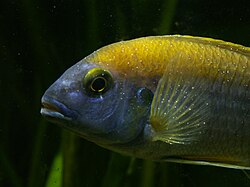Ichthyophthirius
| Ichthyophthirius multifiliis | |
|---|---|
 |
|
| Cichlid showing the white spots characteristic of ich | |
| Scientific classification | |
| Domain: | Eukaryota |
| (unranked): | SAR |
| (unranked): | Alveolata |
| Phylum: | Ciliophora |
| Class: | Oligohymenophorea |
| Order: | Hymenostomatida |
| Family: | Ichthyophthiriidae |
| Genus: | Ichthyophthirius |
| Species: | I. multifiliis |
| Binomial name | |
|
Ichthyophthirius multifiliis Fouquet, 1876 |
|
Ichthyophthirius multifiliis (commonly known as freshwater white spot disease, freshwater ich, or freshwater ick) is a common disease of freshwater fish. It is caused by the protozoan Ichthyopthirius. Ich is one of the most common and persistent diseases in fish. The protozoan is an ectoparasite. White nodules that look like white grains of salt or sugar of up to 1 mm appear on the body, fins and gills. Each white spot is an encysted parasite. It is easily introduced into a fish pond or home aquarium by new fish or equipment which has been moved from one fish-holding unit to another. When the organism gets into a large fish culture facility, it is difficult to control due to its fast reproductive cycle and its unique life stages. If not controlled, there is a 100% mortality rate of fish. With careful treatment, the disease can be controlled but the cost is high in terms of lost fish, labor, and cost of chemicals.
The protozoa damages the gills and skin as it enters the tissues, leading to ulceration and loss of skin. Severe infections rapidly lead to loss of condition and death. Damage to the gills reduces the respiratory efficiency of the fish, reducing its oxygen intake from the water. This causes the fish to become less tolerant to low oxygen concentrations in the water.
The ich protozoan goes through these life stages:
This life cycle is highly dependent on water temperature, and the entire life cycle takes from approximately 7 days at 25 °C (77 °F) to 8 weeks at 6 °C (43 °F).
Marine ich is a similar disease caused by a different ciliate, .
There is no dormant stage in the lifecycle. However, any factor that reduces immunity, such as changes in water temperature and quality, accelerate an outbreak of Ich in a subclinically infected fish. Ammonia, nitrite or high levels of nitrate in water do not in themselves cause clinical cases of Ich. However, poor water quality stresses fish, which allows an outbreak to spread rapidly and increases mortality rates.
Other abiotic factors can increase both fish and tadpole susceptibility to ich. These factors include decreased temperature, predatory cues (crowding, fighting) and increased levels of UV-B radiation.
The diagnosis of "ich" can easily be confirmed by microscopic examination of skin and gills. Remove several "white spots" from an infected fish, then mount them on a microscope slide with a few drops of water and cover with glass. The mature parasite is large and dark (due to thick cilia covering the entire cell). It has a horseshoe-shaped nucleus, which is sometimes visible under 100x magnification. The adult parasite moves slowly by tumbling. The immature forms [tomites] are smaller, translucent, and move quickly.
...
Wikipedia
